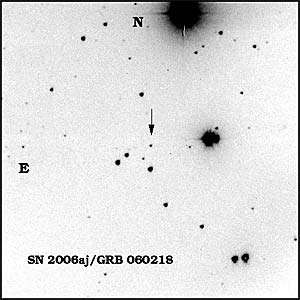X-ray flashes tied to low-end massive stars

Massive stars as much as 40 times bigger than our sun often produce brilliant gamma-ray bursts when they explode, leaving behind black holes.
Observations of a supernova discovered earlier this year, however, suggest that when stars half that size explode, they too can produce bursts, though such bursts are weaker flashes of high-energy X rays instead of intense beams of gamma rays.
The supernova observed on Feb. 18, 2006, may even have left behind a neutron star instead of a black hole, which shows that a large range of stellar sizes - at least between 20 and 40 solar masses - can produce bursts when they explode, according to Alex Filippenko, professor of astronomy at the University of California, Berkeley.
Filippenko is co-author on two of four papers appearing in the Aug. 31 issue of Nature describing radio, optical, X-ray and gamma-ray observations of the supernova, called SN2006aj.
Long-duration gamma-ray bursts (GRBs) are among the most energetic cosmic processes known, outshining for a split second the rest of the universe. If, as thought, these bursts are emitted during the collapse of a massive star, these stars must be bizarre creatures - naked carbon-oxygen stars that flatten as they collapse into a black hole. These explosions produce Type Ic supernovae, what some astronomers have taken to calling hypernovae.
Filippenko's colleagues, Paolo A. Mazzali and Elena Pian of the Trieste Observatory in Italy and the Kavli Institute for Theoretical Physics at UC Santa Barbara, have theorized that an asymmetric exploding star produces out of each of its poles a tight beam of matter and energy that generates an intense burst of gamma rays.
This "collapsar" model for the collapse of a rapidly rotating, massive star into a black hole was originally proposed and developed by Stanford E. Woosley and Andrew I. MacFadyen of UC Santa Cruz. MacFadyen is now at the California Institute of Technology.
The newly discovered connection between Type Ic supernovae and X-ray flashes implies that the collapsar model applies to smaller progenitor stars as well as more massive stars that become hypernovae and generate gamma-ray bursts, the authors say. Alternatively, if a neutron star resulted from the explosion, a strong magnetic field, akin to that in a magnetar, may have been necessary to produce the burst.
The X-ray flash and associated weak gamma-ray burst, designated GRB060218, were observed first by NASA's Swift satellite in a region of the sky occupied by the constellation Aries. Ground- and satellite-based telescopes in the ensuing days swiveled to observe the object, and caught the optical afterglow of a supernova in a galaxy 440 million light years away.
Filippenko's team obtained a spectrum of the supernova with the Shane 3-meter telescope at the University of California's Lick Observatory and measured its fading brightness with the Katzman Automatic Imaging Telescope (KAIT), combining their data with observations by the European Southern Observatory's 8.2-meter Very Large Telescope.
Together these observations revealed the supernova to be a Type Ic and also confirmed its association with the X-ray flash and weak gamma-ray burst. Another team headed by Sergio Campana of Osservatorio Astronomico di Brera, Merate, Italy, also showed that GRB060218 was associated with supernova SN2006aj.
Subsequent analysis by Filippenko, Mazzali, Pian and their colleagues indicated that the star originally had a mass about 20 times that of the sun, the lower limit for stars that explode to form black holes. The team states in its Nature paper that the star's mass was right at this lower limit, and thus may have produced a neutron star, but Filippenko is not so sure. The lower limit for stars that will end up as black holes is uncertain, so a 20-solar mass star might go either way, he said. Whatever the resulting object, by the time the star exploded, it probably had shed most of this mass, slimming down to little more than 3 to 4 solar masses.
"It's an interesting result whether it's a neutron star or a black hole," Filippenko said. "Because massive stars are hard to form, there may be many more supernovae like this producing X-ray flashes than explosions of very massive stars to produce gamma-ray bursts."
Another group led by Alicia Soderberg of the California Institute of Technology deduced from its observations that the burst was around a hundred times less energetic than ordinary gamma-ray bursts.
The burst was unusual in another sense: it produced X rays for several weeks. The researchers hypothesize that the burst lasted so long because of the large amount of high-energy debris that was thrown out by the explosion.
Co-authors of the papers include scientists from China's National Astronomical Observatories, the University of Tokyo and various institutions around the world.
Source: University of California, Berkeley





















